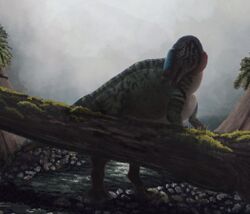Biology:Kelumapusaura
| Kelumapusaura | |
|---|---|

| |
| Life restoration | |
| Scientific classification | |
| Domain: | Eukaryota |
| Kingdom: | Animalia |
| Phylum: | Chordata |
| Clade: | Dinosauria |
| Clade: | †Ornithischia |
| Clade: | †Ornithopoda |
| Family: | †Hadrosauridae |
| Subfamily: | †Saurolophinae |
| Clade: | †Austrokritosauria |
| Genus: | †Kelumapusaura Rozadilla et al., 2022 |
| Species: | †K. machi
|
| Binomial name | |
| †Kelumapusaura machi Rozzadilla et al., 2022
| |
Kelumapusaura (meaning "red earth lizard") is a genus of saurolophine hadrosaur from the Late Cretaceous Allen Formation in what is now Patagonia in Argentina . The type and only species is K. machi, known from a bonebed of various individuals.[1]
Discovery
The generic name, "Kelumapusaura," combines "kelumapu," the Mapudungun word for "red earth," and the feminine form of the Greek "sauros," meaning "lizard." The specific name, "machi," is derived from a word from the Mapuche people for "shaman."[1]
Description
The describing authors estimate that Kelumapusaura would have been 8 to 9 metres (26 to 30 ft) long.[1]
Classification
Rozadilla et al. (2022) named Kelumapusaura and the closely related Huallasaurus, recovering them in a clade of entirely South American saurolophines.[1] In the 2023 description of the South American hadrosauroid Gonkoken, Alarcón-Muñoz et al. recovered similar results, implementing a modified version of the phylogenetic matrix of Rozadilla et al. They named the clade containing Kelumapusaura, Huallasaurus, and other South American saurolophines as the Austrokritosauria, recovering it as the sister taxon to the Kritosaurini. The results of their phylogenetic analyses of Saurolophinae are displayed in the cladogram below:[2]
| Saurolophinae |
| ||||||||||||||||||||||||||||||||||||||||||||||||||||||||||||||||||||||||||||||||||||||||||||||||||||||||||||||||||||||||||||||||||||
Paleoecology
Kelumapusaura is known from the Late Cretaceous Allen Formation of Río Negro Province, Argentina . Many other dinosaurs, including titanosaurs, hadrosaurids, abelisaurids, dromaeosaurids, and alvarezsaurids have been named from the formation.[1]
References
- ↑ 1.0 1.1 1.2 1.3 1.4 Rozadilla, Sebastián; Brissón-Egli, Federico; Lisandro Agnolín, Federico; Aranciaga-Rolando, Alexis Mauro; Novas, Fernando Emilio (2022). "A new hadrosaurid (Dinosauria: Ornithischia) from the Late Cretaceous of northern Patagonia and the radiation of South American hadrosaurids". Journal of Systematic Palaeontology. doi:10.1080/14772019.2021.2020917. https://www.researchgate.net/publication/358834727_A_new_hadrosaurid_Dinosauria_Ornithischia_from_the_Late_Cretaceous_of_northern_Patagonia_and_the_radiation_of_South_American_hadrosaurids.
- ↑ Alarcón-Muñoz, Jhonatan; Vargas, Alexander O.; Püschel, Hans P.; Soto-Acuña, Sergio; Manríquez, Leslie; Leppe, Marcelo; Kaluza, Jonatan; Milla, Verónica et al. (2023-06-16). "Relict duck-billed dinosaurs survived into the last age of the dinosaurs in subantarctic Chile" (in en). Science Advances 9 (24). doi:10.1126/sciadv.adg2456. ISSN 2375-2548.
Wikidata ☰ Q111015077 entry
 |



